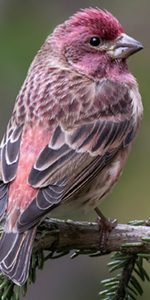| Purple Finch | ||
 |
Classification(s) : | Prey |
| Cat Name : | Cardinal | |
| Common Name : | Purple Finch | |
| Scientific Name : | Carpodacus purpureus | |
| Other Name(s) : | ||
| Physical Description : | Purple Finches, despite the name, are anything but purple. They are small and chunky, with a strong, tapered beak and a short tail that is notched at the tip. Male finches have prominent pink-red feathering on their heads and breasts. The back is a dusty brown and the belly is a cloudy white. The color markings are somewhat blended where they touch. The female finch has no red whatsoever, with a streaked belly, yet their faces are colored with strong markings, including a dirty white eye-stripe and a dark line on the throat. Females can be mistaken for the Pine Siskin, which is a finch in the same family, though Purple Finches have a longer wingspan but are smaller overall, and are never yellow. |
|
| Physical Statistics : | Length – 4.7 – 6.3 Inches (12 – 16 Centimeters) |
|
| Behavior : | Purple finches live in high branches of trees, where they feed on seeds and a few insects. They live in moist, cool evergreen forests, as well as in wooded streams and mixed woodland. During the summer breeding season the males’ main priority is to mate with as many females as possible, and they are very aggressive around other males and predators. |
|
| Social Organization : | Purple finches are found in large flocks and are very aggressive. |
|
| Approval Level : | None; These birds are very commonly found in wooded areas, especially where there are pines, firs and evergreens. They are attracted to running water | |
| Kill Difficulty : | Low; These birds have no natural defenses, other than their beak. |
|
| Training Level : | Advanced; These birds live high up in trees and have adapted to detecting predators easily. |
|
| Hunting Tactic : | Birds | |
| Food Quality : | Medium; Purple Finches are small, but good tasting and very nutritious. | |
